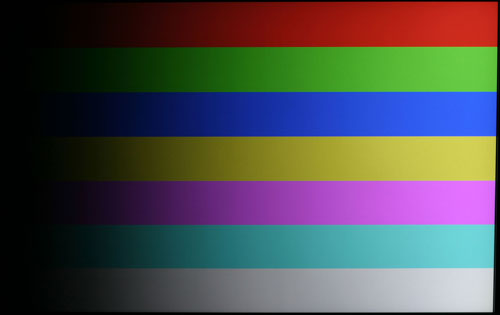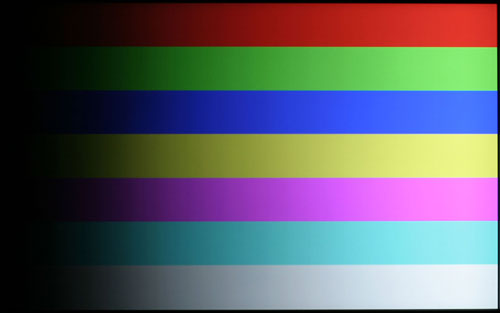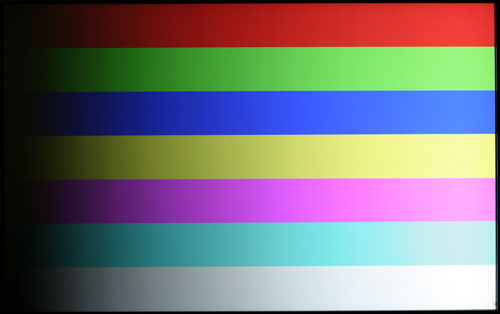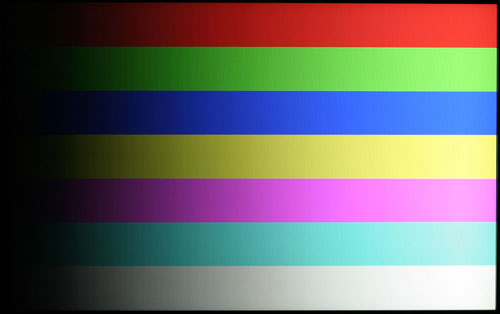Dell 2407WFP and 3007WFP LCD Comparison
by Jarred Walton on March 2, 2007 11:30 AM EST- Posted in
- Displays
Subjective Evaluation
Given that most users do not have access to hardware display calibration tools, we spent some time using the displays without ever properly calibrating them in order to gain an impression of how most users would react. We will start with our subjective evaluation before getting to the actual quantitative results.
Having used several LCDs including a Dell 2405FPW, the newer Dell models definitely look a little better in side-by-side comparisons. If you can't do a side-by-side comparison, though, it is much less likely that you would notice the difference. The newer displays look a little brighter and have slightly better colors and viewing angles, but we could be happy using pretty much any current 24" LCD. Outside of the lack of inputs and the massive size of the 3007WFP, subjectively there really wasn't a huge difference between the various LCDs.
One area that continues to be somewhat irritating on the 24" Dell LCDs is the default resolutions you get in Windows. Naturally 1920x1200 is present, and that will be the desired resolution if at all possible, but most other 16:10 aspect ratio resolutions don't show up and you need to use a utility to add support for 1680x1050 and 1440x900. If you lack the graphics hardware to run some games at native resolution, being able to drop the resolution down one notch while still maintaining a widescreen aspect ratio is convenient. The 30" Dell LCD does much better in the resolution department, with basically every resolution you would expect to find showing up without the need for any utilities/tweaks. We mentioned in the Gateway FPD2485W review that it appeared to have difficulty scaling 1680x1050 to fit its native resolution, while other resolutions scaled better. Both of the Dell LCDs seem to do better overall on scaling, although you still get the typical slightly blurred look when running at non-native resolutions.
The Gateway FPD2485W still holds the record as the brightest large LCD that we've used, but it's almost to the point of being too bright. We haven't felt the need to run any of the LCDs at maximum brightness, but in the case of the Gateway dropping it down to as little as 30% brightness at times was reasonable. So far, we have yet to experience an LCD that doesn't have a moderate amount of backlight bleed, and the brighter the display is the worst backlight bleed tends to be. After using the FPD2485W for a couple weeks, both Dell LCDs are a bit better at producing dark blacks, and unlike the Gateway LCD we didn't notice any issues with uniformity of color/lighting.
We took a closer look at the ability to reproduce a smooth color gradient on all of the displays we've tested so far. The Dell 3007WFP ranks at the top of the chart in terms of producing a smooth gradient, followed closely by the 2407WFP. Meanwhile, the Gateway FPD2485W and the older Dell 2405FPW show some banding issues when viewing gradients, particularly in the darker colors. People who do a lot of image editing are more likely to notice the problems in reproducing smooth gradients, and we actually weren't bothered by any of the monitors, but other users may be more demanding.
Trying to provide a good representation of what the gradients looked like is quite difficult, as you can't take a normal screenshot and using a camera to photograph the display is rather like making a copy of a copy. After a bit of trial and error, we were able to get images that at least convey something of the issues that we noticed with banding. You'll have to ignore the moiré effects that are present on some of the images, and our Canon Digital Rebel was only able to provide a rough approximation of what it's like to look at the screens in person, but for now this will have to do.
Something else we heard about was claims of lag/buffering on the Dell 2407WFP. We never noticed this during testing, but then when you consider screen updates are occurring every 0.017 seconds we're not entirely sure that our eyes are fast enough to pick up something like that. So we plugged a 2405FPW and 2407WFP into two DVI ports on the same computer and set the NVIDIA control panel to clone the output to both displays. We then took some pictures while running 3DMark03, with the 2405FPW on the left and the 2407WFP on the right. The second image is the more interesting, as a couple things become apparent. First, the 2407WFP is certainly no slower than the 2405FPW, and in fact it actually appears to be slightly faster in terms of pixel response times. Note how the frame counter shows 304 on the left and 305 on the right. Second, you can clearly see that there's still pixel lag present on both displays. Most of us don't have a problem with the slight image smearing that occurs on these LCDs, and the camera actually makes it look a lot worse than what we experience in person -- we may have simply captured two frames for all we know -- but this is something that will vary by individual. If you know you are bothered by image smearing, try out a display in person to see if it's suitable for your needs.
Overall, both Dell LCDs continue to rank among the best that we've seen, and with the current prices we would choose them over most competing offerings. We're still in process of reviewing other LCDs, of course, and eventually we expect someone to supplant Dell's current offerings as the preferred LCD, but we would put the 24" and 30" near the top of their respective categories. Certainly, they're more than worthy of serving as the standard against which we will judge future large LCDs. We would rate the 3007WFP as the better quality LCD panel in terms of colors, but only by a small margin, while the 2407WFP wins out in the features department. Whether it's playing games, viewing movies, or just surfing the web we didn't have any complaints about either display.
That's our subjective opinion of how the displays perform, but let's see how they fare in actual quantitative testing.
Given that most users do not have access to hardware display calibration tools, we spent some time using the displays without ever properly calibrating them in order to gain an impression of how most users would react. We will start with our subjective evaluation before getting to the actual quantitative results.
Having used several LCDs including a Dell 2405FPW, the newer Dell models definitely look a little better in side-by-side comparisons. If you can't do a side-by-side comparison, though, it is much less likely that you would notice the difference. The newer displays look a little brighter and have slightly better colors and viewing angles, but we could be happy using pretty much any current 24" LCD. Outside of the lack of inputs and the massive size of the 3007WFP, subjectively there really wasn't a huge difference between the various LCDs.
One area that continues to be somewhat irritating on the 24" Dell LCDs is the default resolutions you get in Windows. Naturally 1920x1200 is present, and that will be the desired resolution if at all possible, but most other 16:10 aspect ratio resolutions don't show up and you need to use a utility to add support for 1680x1050 and 1440x900. If you lack the graphics hardware to run some games at native resolution, being able to drop the resolution down one notch while still maintaining a widescreen aspect ratio is convenient. The 30" Dell LCD does much better in the resolution department, with basically every resolution you would expect to find showing up without the need for any utilities/tweaks. We mentioned in the Gateway FPD2485W review that it appeared to have difficulty scaling 1680x1050 to fit its native resolution, while other resolutions scaled better. Both of the Dell LCDs seem to do better overall on scaling, although you still get the typical slightly blurred look when running at non-native resolutions.
The Gateway FPD2485W still holds the record as the brightest large LCD that we've used, but it's almost to the point of being too bright. We haven't felt the need to run any of the LCDs at maximum brightness, but in the case of the Gateway dropping it down to as little as 30% brightness at times was reasonable. So far, we have yet to experience an LCD that doesn't have a moderate amount of backlight bleed, and the brighter the display is the worst backlight bleed tends to be. After using the FPD2485W for a couple weeks, both Dell LCDs are a bit better at producing dark blacks, and unlike the Gateway LCD we didn't notice any issues with uniformity of color/lighting.
We took a closer look at the ability to reproduce a smooth color gradient on all of the displays we've tested so far. The Dell 3007WFP ranks at the top of the chart in terms of producing a smooth gradient, followed closely by the 2407WFP. Meanwhile, the Gateway FPD2485W and the older Dell 2405FPW show some banding issues when viewing gradients, particularly in the darker colors. People who do a lot of image editing are more likely to notice the problems in reproducing smooth gradients, and we actually weren't bothered by any of the monitors, but other users may be more demanding.
 Dell 3007WFP |
 Dell 2407WFP |
 Gateway FPD2485W |
 Dell 2405FPW |
| Click to enlarge |
Trying to provide a good representation of what the gradients looked like is quite difficult, as you can't take a normal screenshot and using a camera to photograph the display is rather like making a copy of a copy. After a bit of trial and error, we were able to get images that at least convey something of the issues that we noticed with banding. You'll have to ignore the moiré effects that are present on some of the images, and our Canon Digital Rebel was only able to provide a rough approximation of what it's like to look at the screens in person, but for now this will have to do.
 |
 |
| Click to enlarge |
Something else we heard about was claims of lag/buffering on the Dell 2407WFP. We never noticed this during testing, but then when you consider screen updates are occurring every 0.017 seconds we're not entirely sure that our eyes are fast enough to pick up something like that. So we plugged a 2405FPW and 2407WFP into two DVI ports on the same computer and set the NVIDIA control panel to clone the output to both displays. We then took some pictures while running 3DMark03, with the 2405FPW on the left and the 2407WFP on the right. The second image is the more interesting, as a couple things become apparent. First, the 2407WFP is certainly no slower than the 2405FPW, and in fact it actually appears to be slightly faster in terms of pixel response times. Note how the frame counter shows 304 on the left and 305 on the right. Second, you can clearly see that there's still pixel lag present on both displays. Most of us don't have a problem with the slight image smearing that occurs on these LCDs, and the camera actually makes it look a lot worse than what we experience in person -- we may have simply captured two frames for all we know -- but this is something that will vary by individual. If you know you are bothered by image smearing, try out a display in person to see if it's suitable for your needs.
Overall, both Dell LCDs continue to rank among the best that we've seen, and with the current prices we would choose them over most competing offerings. We're still in process of reviewing other LCDs, of course, and eventually we expect someone to supplant Dell's current offerings as the preferred LCD, but we would put the 24" and 30" near the top of their respective categories. Certainly, they're more than worthy of serving as the standard against which we will judge future large LCDs. We would rate the 3007WFP as the better quality LCD panel in terms of colors, but only by a small margin, while the 2407WFP wins out in the features department. Whether it's playing games, viewing movies, or just surfing the web we didn't have any complaints about either display.
That's our subjective opinion of how the displays perform, but let's see how they fare in actual quantitative testing.










62 Comments
View All Comments
Resh - Saturday, March 3, 2007 - link
Thanks Jarred!I wouldn't expect you to print and assess accuracy, but if you could do a photo-specific calibration and test for future reviews, that would be great.
Thanks again and keep up the good work!
BPB - Friday, March 2, 2007 - link
I have two questions. In the Gateway review you mentioned the Gateway did a good job of showing 16:9 movies with the black bars and that the Gateway did 1:1 very well. You also mentioned that you heard the Dell maybe didn't do it as well. So the first question is: did you try this in your test? I just bought the Gateway and like it (I opened the box last night, hours before you posted this review), but I plan on using it to watch DVD's while I work out, as well as using it as my main monitor.The second question is does the Dell have auto-rotate software like Gateway's EzTune? I was told by a Dell rep that it doesn't and that you have to manually change the video drivers. I like to use rotate when working on a website. I can often fit an entire site up and down when rotated. At most I have to scroll very little.
Oh well, looks like I may have to beg BestBuy to take the FPD2485W back and head up to Costco for the Dell if the Dell does DVD's as well. Of course then the Dell would be a little more as I didn't pay tax or shipping for the Gateway (thanks, NH!) but would have to pay tax for the Dell (arghh to you, MA) making the $5 list price favor of the Dell become a $28.70 favor for the Gateway. I paid $679.99 for the Gateway, the Dell becomes $707.70 with tax.
JarredWalton - Friday, March 2, 2007 - link
Dell locks the scaling to what your drivers specify if you use DVI. ATI doesn't allow 1:1 scaling as far as I know, but they do allow a centered 1:1 image (i.e. black bars). NVIDIA has better options for changing scaling, although I have encountered bugs in the past with their 1:1 scaled option. The Gateway does have controls more like the old 2405FPW (where you could set scaling via the monitor rather than in drivers), but the colors aren't as good overall. In terms of DVD playback, neither display is really good (i.e. less than 3 delta E), and I don't know that subjectively I can see a big difference between the Dell and GW when watching videos. You can always disable DirectDraw to get the color profile applied (it disables overlay)... heh.JarredWalton - Friday, March 2, 2007 - link
Oh, I forgot to say, I don't think there's an auto-rotate software with the Dell. Also, I'm not sure EZtune handles the auto-rotate - I thought it was a function of the drivers, but I could be wrong. I'll have to test it later... right now I need sleep! ;)BPB - Friday, March 2, 2007 - link
Thanks for the quick reply. I had a Gateway 21" before getting the 24" and can attest to the EzTune doing the auto-rotate. It's a very nice feature. Not a deal-breaker type of thing, but it's nice. When I consider the effort it will take to return the Gateway to get the Dell I start to think it probably ain't worth it, the effort, that is.chizow - Friday, March 2, 2007 - link
The 2407WFP REV A04 does 1:1 scaling. It looks like Jarred got an A03 or earlier for the review. I saw the 1:1 scaling option greyed out in the OSD but didn't see it directly mentioned in the review anywhere.Jarred, you gotta include this kind of stuff in your reviews! Its what panel buyers want to know. Also was the 3007 the HC version or standard?
Otherwise nice review; the difference between the 2407 and the FPD2485W is spot-on with my own observations from using both first hand. The one test I felt was flawed was comparing the 2405 and 2407 for input lag. A better test imo would've been testing the 2407 to the FPD2485W or even a 2ms TN or S-IPS. IIRC the 2405 had input lag problems as well, so any lag wouldn't really show when comparing the two.
JarredWalton - Friday, March 2, 2007 - link
I'll see about taking a shot of the FPD2485W vs. 2407WFP for input lag - again, I've never had any issue, but maybe I'm just getting too old and my eyes are slow? :)The LCD I have is revision A01, so some things have apparently changed. Sort of interesting, as I have only had the LCD for a few months... I would have expected something made more recently. I guess Dell hasn't made a point of pushing newer revisions, which isn't too surprising. The 3007 is the standard version as far as I can tell - wouldn't the new HC be a separate model, or are they simply phasing out the older IPS model and moving to a TN or whatever version instead?
chizow - Friday, March 2, 2007 - link
I didn't think it would be that big of a deal either, but after having used both, it is slightly noticeable. Part of it might be psychological, but there's some pretty convincing tests out there that show the input lag can be pretty severe. Similar to your test, they had side-by-side screens where ammo counters were off by 1-2 rounds, objects were in different positions, and other anomalies.Wow A01, surprised it didn't exhibit more serious banding problems. Maybe it was a refurb? The A01 and A02 were supposed to exhibit banding problems similar to the Gateway. But ya Dell is horrible with their panel lottery; if they shipped you guys a panel gratis it was probably a refurb or recycled panel. Makes a lot of sense shipping an old panel to a well-known review site!
The HC is being treated as a new revision afaik. Its been in Asian markets since the new year and has only become available in the US recently to select customers. I think it will eventually just replace the older versions in the channel when it reaches widespread availability. I'm also pretty sure its still IPS, it just increases brightness/contrast since that was the biggest knock on the 3007 apparently.
BPB - Friday, March 2, 2007 - link
I just saw your reply in the forums. Thanks!BPB - Friday, March 2, 2007 - link
So you too would recommend the Dell over the Gateway? If so, would you say like Jarred that the difference is minimal or would you say it's more than minimal?